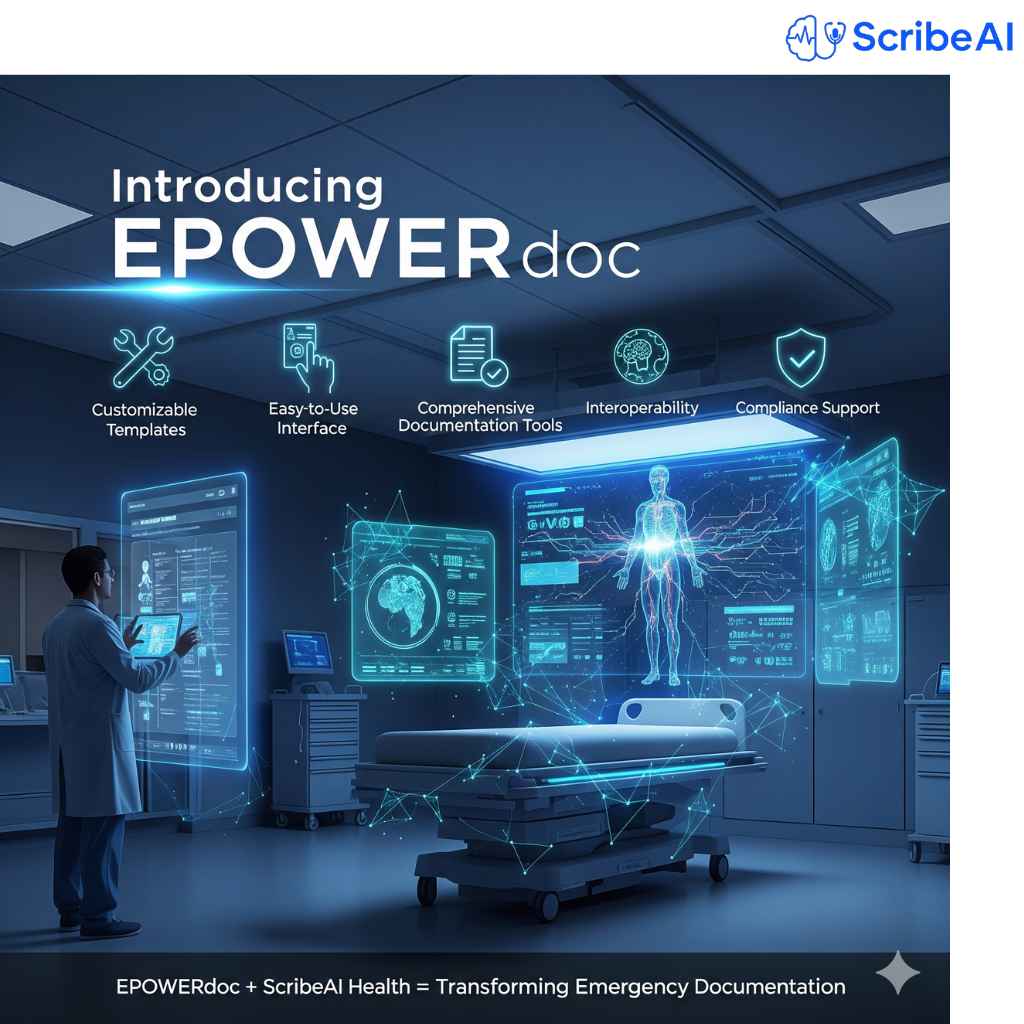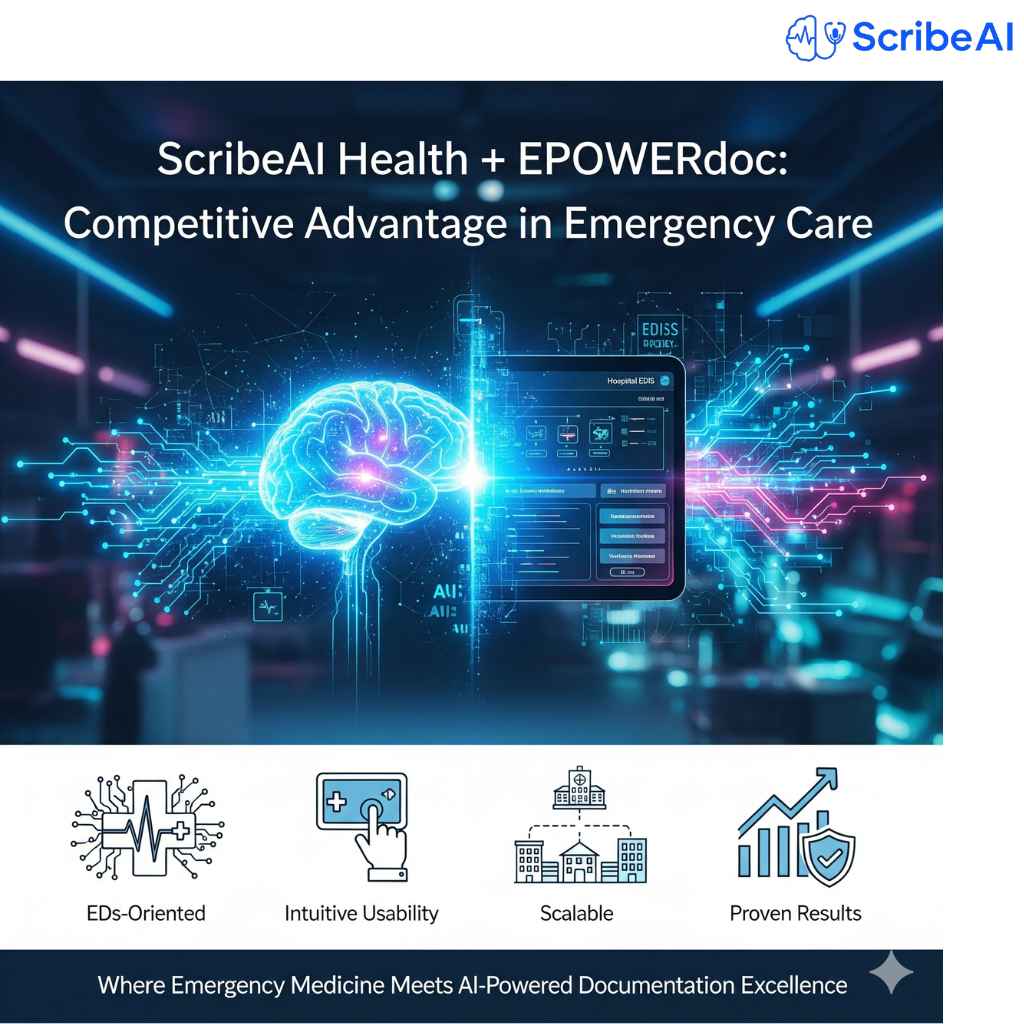The Special Documentation Problems in Emergency Care
The emergency departments work in quite specific circumstances, which complicate recording to a certain degree:
- High Patient Volume: EDs are commonly taking dozens of patients or even hundreds of patients every day.
- Time Sensitivity: The time is always of the essence and the documentation is hard to achieve without interfering with patient care.
- Complications of Cases: Emergency clinicians encounter a wide variety of cases which are unpredictable such as trauma cases and cardiac arrests.
- Regulatory Demands: CMS, HIPAA and hospital policies demand careful documentation.
- Burnout Crisis: Doctors spend time recording as much as 40 percent of their time, which leads to the high levels of burnout.
An American College of Emergency Physicians (ACEP) survey, conducted in 2023, found that more than 60% of ED physicians cite documentation burden as their number one frustration. It is evident that there is an urgent requirement of the solution.
Introducing EPOWERdoc
EPOWERdoc is a state-of-the-art Emergency Department Information System (EDIS) that is developed to facilitate the ED operations. Developed by emergency physicians themselves, EPOWERdoc is speedy, efficient and accurate.
EPOWERdoc has major characteristics such as:
- Customizable Templates: Templates customizable to high-paced ED workflow.
- Easy-to-Use Interface: Built to help reduce the number of clicks and fatigue when charting.
- Comprehensive Documentation Tools: Records chief complaint, histories, diagnoses, procedures and discharge summaries.
- Interoperability: Can be integrated with leading hospital systems and EHRs.
- Compliance Support: Provides proper billing and coding and compliance with documentation regulations.
EPOWERdoc is already a highly efficient system but when it is integrated with
ScribeAI Health, it transforms documentation.

What is ScribeAI Health?
ScribeAI Health is a sophisticated AI based medical scribe that is designed to automate and optimise clinical documentation. Through natural language processing (NLP) and machine learning, ScribeAI Health hears through patient-provider dialogue, transcribes and generates structured documentation in real time.
Features of ScribeAI Health:
- Live Chat: Records live communication in real-time.
- Specialty Adaptability: Knows terminology of emergency medicine.
- EHR Integration: Docs directly enter to systems such as EPOWERdoc.
- Precision of Over 95: Lessens errors in documentation.
- HIPAA-Compliant: Decades safety and secrecy.
- Hybrid Verification: AI + optional human check to be the most accurate.
Integration of ScribeAI Health and EPOWERdoc forms an ecosystem in which clinicians are not required to work with paperwork; instead, they attend to patients.
The Power of Integration: ScribeAI Health + EPOWERdoc
Combined, ScribeAI Health and EPOWERdoc provide a seamless workflow that is expected to run efficiently in the hectic environment of the emergency department.
- Real-Time Charting - Rather than typing notes manually, clinicians can have a conversation with patients and ScribeAI records the conversation and inserts it into EPOWERdoc.
- Greater Speed and Efficiency - ScribeAI templates used in EPOWERdoc pre-populate templates that decrease Redundant entry and clicks.
- Error Minimization - Transcription done by AI has a smaller number of omissions, and the structured documentation is available for compliance and billing.
- Better Compliance - ScribeAI Health provides a comprehensive documentation that is in line with the coding and compliance capabilities of EPOWERdoc.
- Workforce Optimization - With the process of documentation automation, ED workers will be able to manage a large patient load without further burnout.
- Patient-Centered Care - Physicians will have more time to spend at the bedside with documentation simplified, thus increasing satisfaction and trust.
Benefits of the Integration:
1. For Clinicians
· Reduce up to 10+ hours per week in the time spent entering notes manually.
· Minimise after-hours charting, re-establishing work-life balance.
· Get access to quality, organized documentation. Less burnout by administrative overload.
2. For Hospitals
· Reduce ED throughput with the same staff.
· Billing: enlarge billing accuracy and capture.
· Enforce audit/ quality reporting compliance.
· Streamline the cost of staffing through lessening the use of human scribes.
3. For Patients
· Get more active, attentive attention.
· Take advantage of the shorter wait time with increased speed of work.
· Feel confident of the attention and empathy of their physician.
Case Scenarios: Works in Practice
Case 1: Urban Trauma Center
In a high-volume trauma emergency department, physicians indicated that, following ScribeAI Health implementation with EPOWERdoc, they saved 9 hours per week. There was an increase in patient satisfaction by 25 percent due to increased bedside time by the physicians.
Case 2: Community Hospital ED
The integration was adopted by a mid-size community hospital and the documentation error had been reduced by 30% within the institution. The accuracy of billing also increased leading to the increase of revenue by 500,000 in the initial year.
Case 3: Emergency Department in the rural area
ScribeAI Health cut charting time by 40% in a rural ED that had low staffing. The total number of physicians was in a position to serve 15% more patients without the need to hire more.
How Integration Works
ScribeAI Health + EPOWERdoc integration is user-friendly:
· Installation: Little IT support is needed to integrate.
· Real-Time Documentation: ScribeAI listens when patients are being interacted with.
· Data Structuring: Notes are structured and arranged based on templates of EPOWERdoc.
· Checking: Checked by clinicians prior to final submission.
· Compliance Check: EPOWERdoc checks billing and regulatory validity.
These 5 steps will make certain that the documentation is accurate, compliant and efficient.
Ending Clinician Burnout
Emergency burnout is on critical levels. A 2024 Medscape study found that two of every three ED physicians were suffering burnout, much of the frustration caused by documentation requirements. The ScribeAI Health + EPOWERdoc integration resolves this by:
· Reducing administration.
· Giving time to direct patient care.
· Reducing after-hours work.
· Increasing job satisfaction and retention.
ScribeAI Health + EPOWERdoc competitive advantage
What is special about this integration?
- EDs-oriented: In contrast to generic AI scribes, ScribeAI was tuned to emergency medicine.
- Intuitive Usability: Operates in EPOWERdoc physician accessible interface.
- Scalable: Works both at small hospitals and large trauma centers.
- Proven Results: Efficiency, accuracy, and ROI have improved.

Handling of Security and Compliance
The paramount is healthcare data security. Both ScribeAI Health and EPOWERdoc are completely HIPAA-compliant, with encrypted channels in all data transfers. Additionally:
- Information is never kept in amounts exceeding the requirement of compliance.
- It is a role-based access that only authorized personnel can review it.
- The idea of integration conforms to CMS documentation requirements.
The Future of Emergency Documentation
he future of emergency medicine documentation is the partnership of ScribeAI Health with EPOWERdoc. Looking ahead:
- AI-Powered Decision Support: AI will not only write them but also highlight possible diagnoses and treatment recommendations.
- Predictive Analytics: Joint data may be used to determine patient trends to make proactive interventions.
- Cross-System Interoperability: Growing EPOWERdoc to other hospital systems.
The opportunities are enormous, and there is one thing, however, that is obvious; the integration powered by AI is no longer an option and it is the new standard.
Inefficiency cannot be afforded by emergency departments. As the number of patient demands, regulatory pressures, and burnout rates among clinicians increase, new solutions are needed. The combination of ScribeAI Health and EPOWERdoc is a game changer- it provides real-time documentation, enhances compliance and allows physicians to concentrate on patients. With the unleashed potential of AI-assisted scribing and expert ED documentation software, health organizations can achieve much more.
Frequently Asked Questions:
Q1. Are the integration complex to execute?
No. It does not need much IT installation and it can be implemented within a few days.
Q2. Is it voice-recognition friendly to emergency-related terminologies?
Yes. ScribeAI Health is trained in emergency medicine words, guaranteeing the correct translating.
Q3. Will this do away with human scribes?
In many cases, yes. Institutions can however decide to maintain a hybrid.
Q4. Is it HIPAA-compliant?
Yes. Both ScribeAI Health and EPOWERdoc are compliant with the HIPAA and CMS standards.
Q5. Is this tele-triage and virtual ED consults workable?
Yes. Telemedicine environments are assisted by integration.
Q6. Hospitals should expect what ROI?
The majority of the institutions record ROI in 3-6 months in the form of efficiency and revenue acquisition.
Q7. To what degree is the transcription accurate?
There are high levels of accuracy (more than 95) and optional human review.
Q8. Is it scalable to more than one department?
Yes. Although optimized to EDs, integration can be applied to other high-volume departments, such as urgent care.